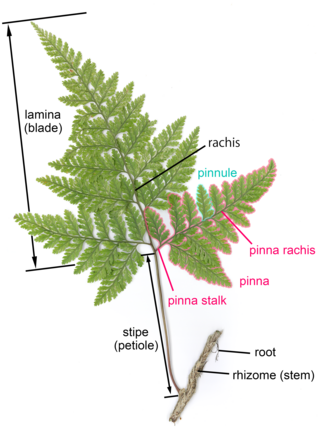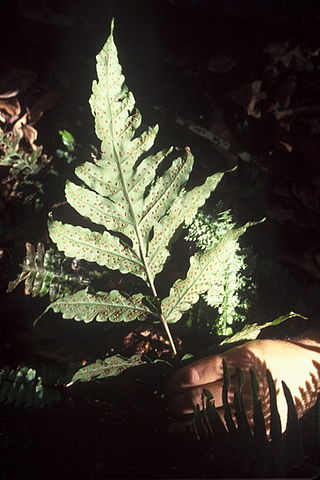
The tree ferns are arborescent (tree-like) ferns that grow with a trunk elevating the fronds above ground level, making them trees. Many extant tree ferns are members of the order Cyatheales, to which belong the families Cyatheaceae, Dicksoniaceae, Metaxyaceae, and Cibotiaceae. It is estimated that Cyatheales originated in the early Jurassic, and is the third group of ferns known to have given rise to tree-like forms. The others are the extinct Tempskya of uncertain position, and Osmundales where the extinct Guaireaceae and some members of Osmundaceae also grew into trees. In addition there were the Psaroniaceae and Tietea in the Marattiales, which is the sister group to most living ferns including Cyatheales.

The ferns are a group of vascular plants that reproduce via spores and have neither seeds nor flowers. They differ from mosses by being vascular, i.e., having specialized tissues that conduct water and nutrients and in having life cycles in which the branched sporophyte is the dominant phase.

A frond is a large, divided leaf. In both common usage and botanical nomenclature, the leaves of ferns are referred to as fronds and some botanists restrict the term to this group. Other botanists allow the term frond to also apply to the large leaves of cycads, as well as palms (Arecaceae) and various other flowering plants, such as mimosa or sumac. "Frond" is commonly used to identify a large, compound leaf, but if the term is used botanically to refer to the leaves of ferns and algae it may be applied to smaller and undivided leaves.

Asplenium platyneuron, commonly known as ebony spleenwort or brownstem spleenwort, is a fern native to North America east of the Rocky Mountains. It takes its common name from its dark, reddish-brown, glossy stipe and rachis, which support a once-divided, pinnate leaf. The fertile fronds, which die off in the winter, are darker green and stand upright, while the sterile fronds are evergreen and lie flat on the ground. An auricle at the base of each pinna points towards the tip of the frond. The dimorphic fronds and alternate, rather than opposite, pinnae distinguish it from the similar black-stemmed spleenwort.

Matteuccia is a genus of ferns with one species: Matteuccia struthiopteris. The species epithet struthiopteris comes from Ancient Greek words στρουθίων (strouthíōn) "ostrich" and πτερίς (pterís) "fern".

The Dryopteridaceae are a family of leptosporangiate ferns in the order Polypodiales. They are known colloquially as the wood ferns. In the Pteridophyte Phylogeny Group classification of 2016 (PPG I), the family is placed in the suborder Polypodiineae. Alternatively, it may be treated as the subfamily Dryopteridoideae of a very broadly defined family Polypodiaceae sensu lato.

Diplazium esculentum, the vegetable fern, is an edible fern found throughout Asia and Oceania. It is probably one of the most commonly consumed fern.

Gymnocarpium dryopteris, the western oakfern, common oak fern, oak fern, or northern oak fern, is a deciduous fern of the family Cystopteridaceae. It is widespread across much of North America and Eurasia. It has been found in Canada, the United States, Greenland, China, Japan, Korea, Russia, and most of Europe. It is a seedless, vascular plant that reproduces via spores and have a life cycle with alternating, free-living sporophyte and gametophyte phases.

Tectaria is a genus of fern in the family Tectariaceae, according to the Pteridophyte Phylogeny Group classification of 2016. Halberd fern is a common name for species in this genus.

Gymnocarpium is a small genus of ferns, called oak ferns. It was once placed with various other groups, including the dryopteroid ferns and the athyrioid ferns. Cladistic analysis has demonstrated that Gymnocarpium and Cystopteris form a natural but relatively primitive clade that is basal to the asplenioid, thelypterioid, and athyrioid ferns comprehensively.

Schizaea is a small genus of specialized ferns in the family Schizaeaceae. Common names include curlygrass fern and comb fern. Some species are very small and inconspicuous, and so may often be overlooked in nature. The genus is distinctive and not at all like the common conception of a fern, though it is still considered a true fern (leptosporangiate). The sterile fronds (trophophylls) are grass-like, and the spore-bearing fertile frond (sporophyll) is similar, but with a small, pinnate fertile segment at its apex. The upper surface of the pinnules bear the sessile capsules. Various of the roughly two dozen species have been reported from widely separated regions, including much of the tropical Old and New World, parts of the Eastern USA, Chile, the Falkland Islands, and various Pacific islands, including several islands of New Caledonia, as well as Australia and New Zealand. In Africa at least two species are endemic to South Africa.

Tectariaceae is a family of leptosporangiate ferns in the order Polypodiales. In the Pteridophyte Phylogeny Group classification of 2016 (PPG I), the family is placed in the suborder Polypodiineae. Alternatively, it may be treated as the subfamily Tectarioideae of a very broadly defined family Polypodiaceae sensu lato. The family comprises seven genera, of which Tectaria is by far the largest.

Helminthostachys zeylanica is a terrestrial, herbaceous fern of southeastern Asia and Australia, commonly known as kamraj and tunjuk-langit. The species is like the other members of its family, it has clusters of sporangia on stems of fertile, spike-like fronds.

Tectaria cicutaria, the button fern, is a species of fern in the family Tectariaceae, native to the Antilles. It has thin, soft, triangular fronds up to about 3.5 feet in length; blades are once- or twice-pinnate with the final segments pinnately-lobed. The rhizome is short and erect.

Aglaomorpha is a genus of ferns in the subfamily Drynarioideae of the family Polypodiaceae. The Pteridophyte Phylogeny Group classification of 2016 uses this genus name, while other sources use Drynaria to include Aglaomorpha. Species are commonly known as basket ferns. As circumscribed in PPG I, the genus contains around 50 species.

Tectaria estremerana is a rare species of fern known by the common name Puerto Rico halberd fern. It is endemic to Puerto Rico. It is a federally listed endangered species of the United States.

Aglaomorpha quercifolia, commonly known as the oakleaf fern or oakleaf basket fern, is a species of Aglaomorpha in the family Polypodiaceae. Other common names for the fern are pakpak lawin, gurar, koi hin, ashvakatri, kabkab, kabkaban, or uphatkarul.

Tectaria gemmifera, the snail fern, is a species of fern in the family Tectariaceae. It is native to Africa from the equator southwards, and is present in the DRC, Uganda, Kenya, Tanzania, Rwanda, Burundi, Angola, Zambia, Malawi, Mozambique, Zimbabwe, South Africa and Madagascar. Its natural habitat is deeply shaded forest floors of moist subtropical or tropical forest, and it occurs from 600 to 2,550 metres above sea level. The Latin name refers to the gemma that are produced by the fronds of this species.
Malaifilix is a genus of ferns in the family Tectariaceae, with a single species Malaifilix grandidentata, according to the Pteridophyte Phylogeny Group classification of 2016 (PPG I).


















